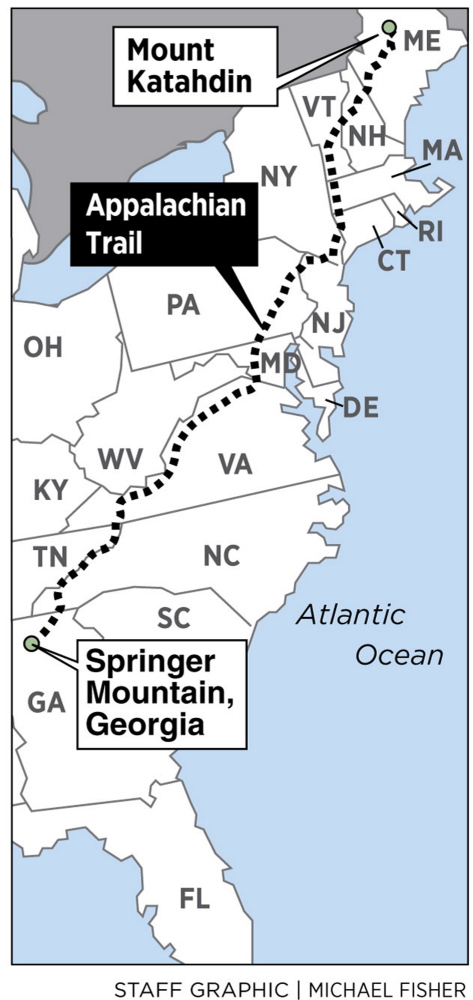Planning and preparation for an Appalachian Trail thru-hike takes time and effort, but it’s a very manageable task if you don’t let yourself get overwhelmed by the thought of six months and 2,200 miles of hiking. A big undertaking like this is best taken one step at a time, before and during the journey.
There’s plenty of information available today – mountains of it, in fact, compared to the dearth of planning resources when I first hiked the AT in 1977. I’ve often told prospective thru-hikers that an AT trek could be planned on the back of a beer napkin. The reality as I’ve rediscovered is it takes a little more doing than that, but is pretty straightforward for the average hiker with patience and determination.
I’ve gotten a lot of questions about the hike and what it takes to make it a success, so here is an overview of my plans and what I’m carrying on my back.
My first step was to buy a set of 20 strip maps of the trail route and a companion guide book with more detailed data by the mile. Using these I developed a spreadsheet outlining where I will buy or mail food and other important items along the way, as well as find stove fuel, lodging, laundry, meals, shuttles to and from towns and such.
Of the 20 mail drops planned, 13 will include freeze-dried and nonperishable foods, while the other seven boxes will contain maps and other small essentials. Where I’m not mailing food I’ll purchase it from grocery stores. Mail drops will go mainly to outfitters and lodging establishments en route, avoiding small town post offices wherever possible.
I selected a mid-March to mid-September timeframe to enjoy the walk through some of all four seasons. I did 8 to 12 miles a day for the first few hundred miles, then 12 to 15 miles for a while after that. The 15- to 20-mile days probably will begin in Virginia as the terrain moderates and the physical conditioning phase has passed.
My trusty Osprey backpack is serving as my home away from home for six months. My base pack weight, as measured by a hanging scale out in the shed at home, is 21 pounds. Add 3 pounds of electronic gear, then a week’s worth of food and 2 liters of water, and the tally is 35 pounds. That’s more than I’d like but it can get darn cold in the southern Appalachians in springtime, so extra warm gear in a necessity. A lighter load will be sufficient in the summer months.
For clothes, I’m starting with a rain jacket and pants, zip-off pants, two T-shirts, long-sleeve shirt, hat and gloves, ball cap, insulated jacket, fleece vest, two undershorts and a bandanna.
For shelter I’ve got a one-person Eureka Spitfire tent, plastic ground sheet, down sleeping bag rated to 20 degrees and an inflatable mattress.
My cook kit includes an MSR Pocket Rocket stove, gas fuel canister, titanium pot and spoon, plastic mug and lighter.
For drinking water I’m carrying a hydration bladder with hose, chemical water treatment drops and a squeeze filter system.
I’m not planning on any blisters – a bold statement but one I’ll probably be able to back up given my extraordinary Lowa Renegade boots, which fit like a glove and wear like a slipper, but provide incredible support. A backup pair is waiting at home if needed. Three pairs of synthetic socks plus liner socks are with me.
Odds and ends include a small first aid and repair kit, bag of personal items like sunscreen and lip balm, and toilet kit. An iPad Mini, Nikon camera and an iPhone plus remote charger and USB cords round out the gear.
Carey Kish of Southwest Harbor is the author of AMC’s Best Day Hikes Along the Maine Coast. Follow Carey’s adventures in his Maineiac Outdoors blog at:
mainetoday.com/blog/ maineiac-outdoors
Send questions/comments to the editors.




Success. Please wait for the page to reload. If the page does not reload within 5 seconds, please refresh the page.
Enter your email and password to access comments.
Hi, to comment on stories you must . This profile is in addition to your subscription and website login.
Already have a commenting profile? .
Invalid username/password.
Please check your email to confirm and complete your registration.
Only subscribers are eligible to post comments. Please subscribe or login first for digital access. Here’s why.
Use the form below to reset your password. When you've submitted your account email, we will send an email with a reset code.